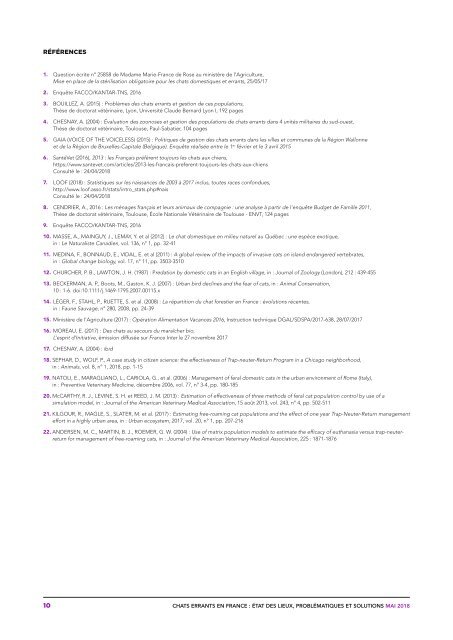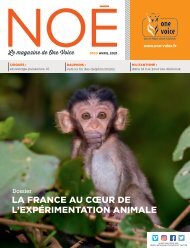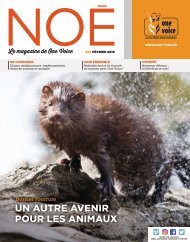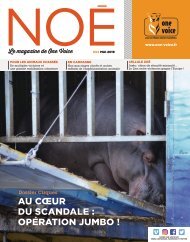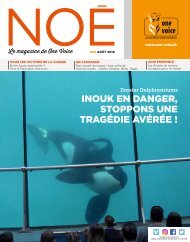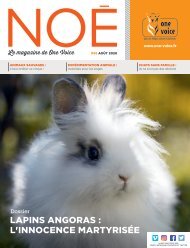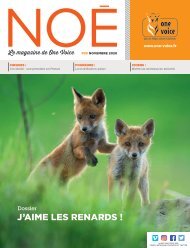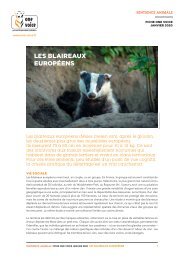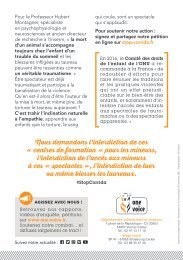Rapport sur l'errance en 2018
You also want an ePaper? Increase the reach of your titles
YUMPU automatically turns print PDFs into web optimized ePapers that Google loves.
RÉFÉRENCES<br />
1. Question écrite n° 25858 de Madame Marie-France de Rose au ministère de l’Agriculture,<br />
Mise <strong>en</strong> place de la stérilisation obligatoire pour les chats domestiques et errants, 25/05/17<br />
2. Enquête FACCO/KANTAR-TNS, 2016<br />
3. BOUILLEZ, A. (2015) : Problèmes des chats errants et gestion de ces populations,<br />
Thèse de doctorat vétérinaire, Lyon, Université Claude Bernard Lyon I, 192 pages<br />
4. CHESNAY, A. (2004) : Évaluation des zoonoses et gestion des populations de chats errants dans 4 unités militaires du sud-ouest,<br />
Thèse de doctorat vétérinaire, Toulouse, Paul-Sabatier, 104 pages<br />
5. GAIA (VOICE OF THE VOICELESS) (2015) : Politiques de gestion des chats errants dans les villes et communes de la Région Wallonne<br />
et de la Région de Bruxelles-Capitale (Belgique). Enquête réalisée <strong>en</strong>tre le 1 er février et le 3 avril 2015<br />
6. SantéVet (2016), 2013 : les Français préfèr<strong>en</strong>t toujours les chats aux chi<strong>en</strong>s,<br />
https://www.santevet.com/articles/2013-les-francais-prefer<strong>en</strong>t-toujours-les-chats-aux-chi<strong>en</strong>s<br />
Consulté le : 24/04/<strong>2018</strong><br />
7. LOOF (<strong>2018</strong>) : Statistiques <strong>sur</strong> les naissances de 2003 à 2017 inclus, toutes races confondues,<br />
http://www.loof.asso.fr/stats/intro_stats.php#nais<br />
Consulté le : 24/04/<strong>2018</strong><br />
8. CENDRIER, A., 2016 : Les ménages français et leurs animaux de compagnie : une analyse à partir de l’<strong>en</strong>quête Budget de Famille 2011,<br />
Thèse de doctorat vétérinaire, Toulouse, École Nationale Vétérinaire de Toulouse - ENVT, 124 pages<br />
9. Enquête FACCO/KANTAR-TNS, 2016<br />
10. MASSE, A., MAINGUY, J., LEMAY, Y. et al (2012) : Le chat domestique <strong>en</strong> milieu naturel au Québec : une espèce exotique,<br />
in : Le Naturaliste Canadi<strong>en</strong>, vol. 136, n° 1, pp. 32-41<br />
11. MEDINA, F., BONNAUD, E., VIDAL, E. et al (2011) : A global review of the impacts of invasive cats on island <strong>en</strong>dangered vertebrates,<br />
in : Global change biology, vol. 17, n° 11, pp. 3503-3510<br />
12. CHURCHER, P. B., LAWTON, J. H. (1987) : Predation by domestic cats in an English village, in : Journal of Zoology (London), 212 : 439-455<br />
13. BECKERMAN, A. P., Boots, M., Gaston, K. J. (2007) : Urban bird declines and the fear of cats, in : Animal Conservation,<br />
10 : 1-6. doi:10.1111/j.1469-1795.2007.00115.x<br />
14. LÉGER, F., STAHL, P., RUETTE, S. et al. (2008) : La répartition du chat forestier <strong>en</strong> France : évolutions réc<strong>en</strong>tes,<br />
in : Faune Sauvage, n° 280, 2008, pp. 24-39<br />
15. Ministère de l’Agriculture (2017) : Opération Alim<strong>en</strong>tation Vacances 2016, Instruction technique DGAL/SDSPA/2017-638, 28/07/2017<br />
16. MOREAU, E. (2017) : Des chats au secours du maraîcher bio,<br />
L’esprit d’Initiative, émission diffusée <strong>sur</strong> France Inter le 27 novembre 2017<br />
17. CHESNAY, A. (2004) : ibid<br />
18. SEPHAR, D., WOLF, P., A case study in citiz<strong>en</strong> sci<strong>en</strong>ce: the effectiv<strong>en</strong>ess of Trap-neuter-Return Program in a Chicago neighborhood,<br />
in : Animals, vol. 8, n° 1, <strong>2018</strong>, pp. 1-15<br />
19. NATOLI, E., MARAGLIANO, L., CARIOLA, G., et al. (2006) : Managem<strong>en</strong>t of feral domestic cats in the urban <strong>en</strong>vironm<strong>en</strong>t of Rome (Italy),<br />
in : Prev<strong>en</strong>tive Veterinary Medicine, décembre 2006, vol. 77, n° 3-4, pp. 180-185<br />
20. McCARTHY, R. J., LEVINE, S. H. et REED, J. M. (2013) : Estimation of effectiv<strong>en</strong>ess of three methods of feral cat population control by use of a<br />
simulation model, in : Journal of the American Veterinary Medical Association, 15 août 2013, vol. 243, n° 4, pp. 502-511<br />
21. KILGOUR, R., MAGLE, S., SLATER, M. et al. (2017) : Estimating free-roaming cat populations and the effect of one year Trap-Neuter-Return managem<strong>en</strong>t<br />
effort in a highly urban area, in : Urban ecosystem, 2017, vol. 20, n° 1, pp. 207-216<br />
22. ANDERSEN, M. C., MARTIN, B. J., ROEMER, G. W. (2004) : Use of matrix population models to estimate the efficacy of euthanasia versus trap-neuterreturn<br />
for managem<strong>en</strong>t of free-roaming cats, in : Journal of the American Veterinary Medical Association, 225 : 1871-1876<br />
10 CHATS ERRANTS EN FRANCE : ÉTAT DES LIEUX, PROBLÉMATIQUES ET SOLUTIONS MAI <strong>2018</strong>


